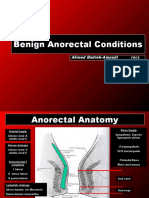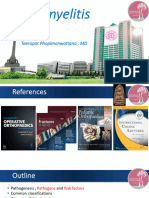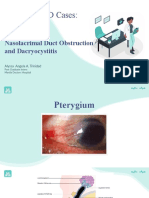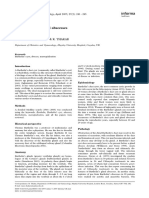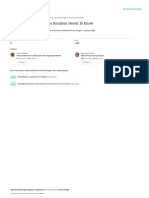Professional Documents
Culture Documents
A Rare Case of Pyogenic Liver Abscess With Perforative Caecal Peritonitis
Copyright
Available Formats
Share this document
Did you find this document useful?
Is this content inappropriate?
Report this DocumentCopyright:
Available Formats
A Rare Case of Pyogenic Liver Abscess With Perforative Caecal Peritonitis
Copyright:
Available Formats
Volume 5, Issue 10, October – 2020 International Journal of Innovative Science and Research Technology
ISSN No:-2456-2165
A Rare Case of Pyogenic Liver Abscess with
Perforative Caecal Peritonitis
Dr. Pratima Bisen Sanjitkumar M. Sant
Department of Pediatrics, Department of Surgery,
Grant Government Medical College & Grant Government Medical College,
Sir J.J. Group of Hospitals, Sir J.J. Group of Hospitals,
Mumbai-400008, Maharashtra, India Mumbai-400008, Maharashtra, India
Dr. Praveen Davuluri
Department of Community Medicine,
Seth G.S. Medical College & K.E.M. Hospital,
Mumbai-400012, Maharashtra, India
Abstract:- Pyogenic liver abscess (PLA) has always been 3 days and got relieved after taking medication. Since then
an important and life-threatening scenario and its the child was passing stools normally.
diagnosis has always been a challenge for physicians.
Liver abscesses are frequently encountered in pediatric On general examination, child was afebrile with pulse
population in the tropical and subtropical regions. We rate: 98/min, respiratory rate: 24/min and Blood Pressure:
present a case of pyogenic liver abscess with caecal 104/60mmHg. Pallor and icterus were present.
perforative peritonitis. Due to the critical clinical
condition caused by the sepsis and contained rupture of Abdomen was distended, umbilicus was central with
the abscess we opted for open surgical drainage, with an transverse slit. Diffuse tenderness was present with guarding.
acceptable postoperative protocol. Clinical presentation, Liver was palpable 2 cm below right costal margins along
diagnostic techniques and current management options mid-clavicular line. It was smooth, soft to firm, tender and
are discussed. both lobes were enlarged. Spleen was just palpable and firm.
Bowel sounds were present. On respiratory system
Keywords:- Pyogenic Liver Abscess, E.Coli, Caecal examination, Chest was bilaterally symmetrical; chest
Perforation. movement was slightly decreased in left lower zone with a
dull note on percussion and air entry was reduced in same
I. INTRODUCTION area. There was no other systemic abnormality. Routine
Investigations were done and the results are depicted in Table
Pyogenic liver abscess (PLA) is an important cause of 1.
morbidity and mortality. Its diagnosis is always challenging,
mainly because there is a significant clinical and radiological Sr. No. Investigation Data
overlap with other hepatic conditionssuch as amoebic
1 Haemoglobin 12.4 g%
abscess and infected hydatid cyst. The treatment options of
pyogenic liver abscess have included both 2 Total Leucocyte Count 24500/cu.mm
medical(antibiotics alone) and surgical interventions (needle 3 C-Reactive Protein 131.2 mg/L
aspiration, catheter drainage, endoscopic drainage or open 4 ESR 100 mm/hr
surgical drainage). Imaging studies [ultrasonography (USG)
and computed tomography (CT)] aid in diagnosis (1). We 5 PT; aPTT; INR 14s; 34s; 1
present a case of immunocompetant girl with pyogenic liver SGOT; SGPT; Alkaline 50U/L; 64U/L;
6
abscess with caecal perforative peritonitis. Phosphatase 104U/L
2.4 mg/dL; 6.6
7 Bilirubin; Protein; Albumin
II. CASE REPORT g/dL; 2.4 g/dL
8 HIV; HBSAg; HCV Non-reactive
The 13 year old girl had presented with the complaints Pus cells: 18-20/hpf
of fever and vomiting since 12 days along with pain in 9 Stool routine microscopy
& mucus ++
abdomen since 10 days. Fever was associated with chills and Table 1: Investigations
rigors. It was high grade, continuous in nature and increased
since last 3 days. Vomiting 3-4 episodes daily, containing Ultrasonography of Abdomen was suggestive of mild
undigested food particles usually within 30 minutes after hepatomegaly with liver abscess of 70 x 66 x 65 mm (158 ml
having food. Pain in abdomen was dull aching, initially more volume) in right lobe of liver and also a large liquefied
in the right hypochondrium and in epigastric region and since exophytic abscess arising from left lobe (89 x 77 x 70 mm)
last 3 days it was diffuse. There was also history of loose which was sub-diaphragmatic and caused mild elevation of
stools (6-8 episodes per day) 12 days back which lasted for 2- left dome of diaphragm. There was evidence of free fluid in
abdomen. Ultrasonography of thorax was suggestive of
IJISRT20OCT244 www.ijisrt.com 826
Volume 5, Issue 10, October – 2020 International Journal of Innovative Science and Research Technology
ISSN No:-2456-2165
minimal left sided pleural effusion with moderate ascites may show hepatomegaly and right upper quadrant pain
with septations within. Pleural fluid tapping was suggestive although this is seen in only about 50% of cases (4).
of normal study. No organisms were isolated on blood
culture. The most common laboratory abnormalities are
hypoalbuminemia, elevated liver enzymes, and leucocytosis
Injection pantoprazole, cefotaxime and metronidazole (5). Computed Tomography or USG aid in
were started. Surgical reference was done and emergency diagnosis.Ultrasonography is the investigation of choice and
open surgical drainage was advised. Exploratory laparotomy can detect almost 100% of abscesses (6).
was done where caecal perforation was detected which was
5mm in size. Closure of caecal perforation with loop The antibiotics are usually administered intravenously
ileostomy was done along with aspiration of liver abscess. for at least 14 days, followed by oral administration for 4
500 ml of serous fluid with pus flakes was seen in pelvis weeks (6). USG-guided percutaneous needle aspiration is
which was aspirated. usually the preferred modality of treatment as it is safe, rapid
and simple. (7). Minor complications associated with this
After the procedure, the child was kept nil by mouth. procedure are hemorrhage into the abscess cavity and
Child was gradually started on liquid feeds and as she was pericatheter leak (8). Open surgical intervention is now
tolerating it, solid food was introduced subsequently and advised for (a) Non-response to needle aspiration or catheter
drains were gradually removed one by one. drainage; (b) large size of abscess; (c) when risk of rupture
is high; (d)contained rupture and (e) presence of peritonitis.
On culture of peritoneal fluid, E. Coli was seen that was Surgical intervention is associated with complications such
sentive to amikacin, gentamycin, tigecycline and colistin. As as respiratory infection, wound infection, ileus, intra-
per culture report, antibiotics were then added. Liver abscess abdominal collections, wound dehiscence, hemorrhages,
pus was sent for microscopy which showed gram negative biliary fistula and increased mortality (9). We opted for open
E.coli bacilli. surgical drainage for our case as the patient had presented
with a contained rupture of the liver abscess. However, with
Repeat ultrasonography was done after 7 days which the introduction of antibiotic therapy, imaging studies and
showed 20 to 25 cc of hypoechoic partially liquefied liver the drainage success, mortality rates have decreased to a
abscess. Patient was discharged after completing 2 weeks of large extent.
intravenous antibiotics. She was advised oral antibiotics for
one month. After 1 month, the patient was called for follow- REFERENCES
up and closure of ileostomy. Patient tolerated the procedure
well. Antibiotics were continued and repeat USG abdomen [1]. Mishra K, Basu S, Roychoudhury S, Kumar P. Liver
was done which was suggestive of residual liver abscess less abscess in children: an overview. World J Pediatr.
than 2cm. Patient was discharged after 1 week. 2010;6(3):210-216
[2]. Branum GD, Tyson GS, Branum MA, Meyers WC.
III. DISCUSSION Hepatic abscess. Changes in etiology, diagnosis, and
management. Ann Surg. 1990 Dec. 212(6):655-62.
Pyogenic liver abscesses are rare in children with [3]. Gyorffy EJ, Frey CF, Silva J Jr, McGahan J. Pyogenic
incidence of over 79 per 100000 hospitalizations. In a meta- liver abscess. Diagnostic and therapeutic strategies.Ann
analysis, Mishra et. al. reported that a majority (more than Surg. 1987 Dec. 206(6):699-705.
65%) occur in the right lobe and are usually solitary (1). The [4]. Johannsen EC, Sifri CD, Madoff LC. Pyogenic liver
most common organism responsible for PLA in children is abscesses. Infect Dis Clin North
Staphylococcus aureus; other species implicated are E. coli, Am.2000;14(3):547Y563.
Klebsiella, Enterobacter and anaerobes (1). Blood culture [5]. Kaplan GG, Gregson DB, Laupland KB. Population-
results are usually positive in one-third of patients presenting based study of the epidemiology of and the risk factors
with PLA. Negative cultures are usually obtained if patients for pyogenic liver abscess. Clin Gastroenterol
have been pre-treated with antibiotics. Almost 50% of Hepatol. 2004;2:1032.
patients may also have positive cultures from the material [6]. Donovan AJ, Yellin AE, Ralls PW. Hepatic abscess
obtained from the abscesses. Cultures usually demonstrate World J Surg 1991;15:162-9.
gram-negative aerobes and anaerobes (2, 3). Pyogenic liver [7]. Rajak CL, Gupta S, Jain S, Chawla Y, Gulati M, Suri S.
abscess can be caused by bacteria gaining entry into the liver Percutaneous treatment of liver abscesses: needle
via (a) portal circulation in case of omphalitis, portal vein aspiration versus catheter drainage. AJR
pyleplebitis and intraabdominal infection; (b) a primary 1998;170:1035-1039.
bacteremia or bacteremia secondary to billiary tract diseases [8]. Petri A, Hohn J, Hodi Z, Wolfard A, Balogh A.
or infections and (c) rarely after percutaneous liver biopsy. Pyogenic liver abscess: 20 years of experience:
comparison of results of treatment in two periods.
Usually, patients with liver abscess present with fever Langenbecks Arch Surg 2002;387:27-31.
and abdominal pain. Presentation can include a broad range [9]. Kurland JE, Brann OS. Pyogenic and amebic liver
of complaints including nausea, vomiting, weight loss, abscesses. Curr Gastroenterol Rep 2004;6:273-6.
jaundice etc. In addition to jaundice, systemic examination
IJISRT20OCT244 www.ijisrt.com 827
You might also like
- An Analysis on Mental Health Issues among IndividualsDocument6 pagesAn Analysis on Mental Health Issues among IndividualsInternational Journal of Innovative Science and Research TechnologyNo ratings yet
- Harnessing Open Innovation for Translating Global Languages into Indian LanuagesDocument7 pagesHarnessing Open Innovation for Translating Global Languages into Indian LanuagesInternational Journal of Innovative Science and Research TechnologyNo ratings yet
- Diabetic Retinopathy Stage Detection Using CNN and Inception V3Document9 pagesDiabetic Retinopathy Stage Detection Using CNN and Inception V3International Journal of Innovative Science and Research TechnologyNo ratings yet
- Investigating Factors Influencing Employee Absenteeism: A Case Study of Secondary Schools in MuscatDocument16 pagesInvestigating Factors Influencing Employee Absenteeism: A Case Study of Secondary Schools in MuscatInternational Journal of Innovative Science and Research TechnologyNo ratings yet
- Exploring the Molecular Docking Interactions between the Polyherbal Formulation Ibadhychooranam and Human Aldose Reductase Enzyme as a Novel Approach for Investigating its Potential Efficacy in Management of CataractDocument7 pagesExploring the Molecular Docking Interactions between the Polyherbal Formulation Ibadhychooranam and Human Aldose Reductase Enzyme as a Novel Approach for Investigating its Potential Efficacy in Management of CataractInternational Journal of Innovative Science and Research TechnologyNo ratings yet
- The Making of Object Recognition Eyeglasses for the Visually Impaired using Image AIDocument6 pagesThe Making of Object Recognition Eyeglasses for the Visually Impaired using Image AIInternational Journal of Innovative Science and Research TechnologyNo ratings yet
- The Relationship between Teacher Reflective Practice and Students Engagement in the Public Elementary SchoolDocument31 pagesThe Relationship between Teacher Reflective Practice and Students Engagement in the Public Elementary SchoolInternational Journal of Innovative Science and Research TechnologyNo ratings yet
- Dense Wavelength Division Multiplexing (DWDM) in IT Networks: A Leap Beyond Synchronous Digital Hierarchy (SDH)Document2 pagesDense Wavelength Division Multiplexing (DWDM) in IT Networks: A Leap Beyond Synchronous Digital Hierarchy (SDH)International Journal of Innovative Science and Research TechnologyNo ratings yet
- Comparatively Design and Analyze Elevated Rectangular Water Reservoir with and without Bracing for Different Stagging HeightDocument4 pagesComparatively Design and Analyze Elevated Rectangular Water Reservoir with and without Bracing for Different Stagging HeightInternational Journal of Innovative Science and Research TechnologyNo ratings yet
- The Impact of Digital Marketing Dimensions on Customer SatisfactionDocument6 pagesThe Impact of Digital Marketing Dimensions on Customer SatisfactionInternational Journal of Innovative Science and Research TechnologyNo ratings yet
- Electro-Optics Properties of Intact Cocoa Beans based on Near Infrared TechnologyDocument7 pagesElectro-Optics Properties of Intact Cocoa Beans based on Near Infrared TechnologyInternational Journal of Innovative Science and Research TechnologyNo ratings yet
- Formulation and Evaluation of Poly Herbal Body ScrubDocument6 pagesFormulation and Evaluation of Poly Herbal Body ScrubInternational Journal of Innovative Science and Research TechnologyNo ratings yet
- Advancing Healthcare Predictions: Harnessing Machine Learning for Accurate Health Index PrognosisDocument8 pagesAdvancing Healthcare Predictions: Harnessing Machine Learning for Accurate Health Index PrognosisInternational Journal of Innovative Science and Research TechnologyNo ratings yet
- The Utilization of Date Palm (Phoenix dactylifera) Leaf Fiber as a Main Component in Making an Improvised Water FilterDocument11 pagesThe Utilization of Date Palm (Phoenix dactylifera) Leaf Fiber as a Main Component in Making an Improvised Water FilterInternational Journal of Innovative Science and Research TechnologyNo ratings yet
- Cyberbullying: Legal and Ethical Implications, Challenges and Opportunities for Policy DevelopmentDocument7 pagesCyberbullying: Legal and Ethical Implications, Challenges and Opportunities for Policy DevelopmentInternational Journal of Innovative Science and Research TechnologyNo ratings yet
- Auto Encoder Driven Hybrid Pipelines for Image Deblurring using NAFNETDocument6 pagesAuto Encoder Driven Hybrid Pipelines for Image Deblurring using NAFNETInternational Journal of Innovative Science and Research TechnologyNo ratings yet
- Terracing as an Old-Style Scheme of Soil Water Preservation in Djingliya-Mandara Mountains- CameroonDocument14 pagesTerracing as an Old-Style Scheme of Soil Water Preservation in Djingliya-Mandara Mountains- CameroonInternational Journal of Innovative Science and Research TechnologyNo ratings yet
- A Survey of the Plastic Waste used in Paving BlocksDocument4 pagesA Survey of the Plastic Waste used in Paving BlocksInternational Journal of Innovative Science and Research TechnologyNo ratings yet
- Hepatic Portovenous Gas in a Young MaleDocument2 pagesHepatic Portovenous Gas in a Young MaleInternational Journal of Innovative Science and Research TechnologyNo ratings yet
- Design, Development and Evaluation of Methi-Shikakai Herbal ShampooDocument8 pagesDesign, Development and Evaluation of Methi-Shikakai Herbal ShampooInternational Journal of Innovative Science and Research Technology100% (3)
- Explorning the Role of Machine Learning in Enhancing Cloud SecurityDocument5 pagesExplorning the Role of Machine Learning in Enhancing Cloud SecurityInternational Journal of Innovative Science and Research TechnologyNo ratings yet
- A Review: Pink Eye Outbreak in IndiaDocument3 pagesA Review: Pink Eye Outbreak in IndiaInternational Journal of Innovative Science and Research TechnologyNo ratings yet
- Automatic Power Factor ControllerDocument4 pagesAutomatic Power Factor ControllerInternational Journal of Innovative Science and Research TechnologyNo ratings yet
- Review of Biomechanics in Footwear Design and Development: An Exploration of Key Concepts and InnovationsDocument5 pagesReview of Biomechanics in Footwear Design and Development: An Exploration of Key Concepts and InnovationsInternational Journal of Innovative Science and Research TechnologyNo ratings yet
- Mobile Distractions among Adolescents: Impact on Learning in the Aftermath of COVID-19 in IndiaDocument2 pagesMobile Distractions among Adolescents: Impact on Learning in the Aftermath of COVID-19 in IndiaInternational Journal of Innovative Science and Research TechnologyNo ratings yet
- Studying the Situation and Proposing Some Basic Solutions to Improve Psychological Harmony Between Managerial Staff and Students of Medical Universities in Hanoi AreaDocument5 pagesStudying the Situation and Proposing Some Basic Solutions to Improve Psychological Harmony Between Managerial Staff and Students of Medical Universities in Hanoi AreaInternational Journal of Innovative Science and Research TechnologyNo ratings yet
- Navigating Digitalization: AHP Insights for SMEs' Strategic TransformationDocument11 pagesNavigating Digitalization: AHP Insights for SMEs' Strategic TransformationInternational Journal of Innovative Science and Research TechnologyNo ratings yet
- Drug Dosage Control System Using Reinforcement LearningDocument8 pagesDrug Dosage Control System Using Reinforcement LearningInternational Journal of Innovative Science and Research TechnologyNo ratings yet
- The Effect of Time Variables as Predictors of Senior Secondary School Students' Mathematical Performance Department of Mathematics Education Freetown PolytechnicDocument7 pagesThe Effect of Time Variables as Predictors of Senior Secondary School Students' Mathematical Performance Department of Mathematics Education Freetown PolytechnicInternational Journal of Innovative Science and Research TechnologyNo ratings yet
- Formation of New Technology in Automated Highway System in Peripheral HighwayDocument6 pagesFormation of New Technology in Automated Highway System in Peripheral HighwayInternational Journal of Innovative Science and Research TechnologyNo ratings yet
- The Subtle Art of Not Giving a F*ck: A Counterintuitive Approach to Living a Good LifeFrom EverandThe Subtle Art of Not Giving a F*ck: A Counterintuitive Approach to Living a Good LifeRating: 4 out of 5 stars4/5 (5794)
- Shoe Dog: A Memoir by the Creator of NikeFrom EverandShoe Dog: A Memoir by the Creator of NikeRating: 4.5 out of 5 stars4.5/5 (537)
- The Little Book of Hygge: Danish Secrets to Happy LivingFrom EverandThe Little Book of Hygge: Danish Secrets to Happy LivingRating: 3.5 out of 5 stars3.5/5 (399)
- The Yellow House: A Memoir (2019 National Book Award Winner)From EverandThe Yellow House: A Memoir (2019 National Book Award Winner)Rating: 4 out of 5 stars4/5 (98)
- Never Split the Difference: Negotiating As If Your Life Depended On ItFrom EverandNever Split the Difference: Negotiating As If Your Life Depended On ItRating: 4.5 out of 5 stars4.5/5 (838)
- Elon Musk: Tesla, SpaceX, and the Quest for a Fantastic FutureFrom EverandElon Musk: Tesla, SpaceX, and the Quest for a Fantastic FutureRating: 4.5 out of 5 stars4.5/5 (474)
- A Heartbreaking Work Of Staggering Genius: A Memoir Based on a True StoryFrom EverandA Heartbreaking Work Of Staggering Genius: A Memoir Based on a True StoryRating: 3.5 out of 5 stars3.5/5 (231)
- Hidden Figures: The American Dream and the Untold Story of the Black Women Mathematicians Who Helped Win the Space RaceFrom EverandHidden Figures: The American Dream and the Untold Story of the Black Women Mathematicians Who Helped Win the Space RaceRating: 4 out of 5 stars4/5 (894)
- On Fire: The (Burning) Case for a Green New DealFrom EverandOn Fire: The (Burning) Case for a Green New DealRating: 4 out of 5 stars4/5 (73)
- The Hard Thing About Hard Things: Building a Business When There Are No Easy AnswersFrom EverandThe Hard Thing About Hard Things: Building a Business When There Are No Easy AnswersRating: 4.5 out of 5 stars4.5/5 (344)
- The Emperor of All Maladies: A Biography of CancerFrom EverandThe Emperor of All Maladies: A Biography of CancerRating: 4.5 out of 5 stars4.5/5 (271)
- Grit: The Power of Passion and PerseveranceFrom EverandGrit: The Power of Passion and PerseveranceRating: 4 out of 5 stars4/5 (587)
- The World Is Flat 3.0: A Brief History of the Twenty-first CenturyFrom EverandThe World Is Flat 3.0: A Brief History of the Twenty-first CenturyRating: 3.5 out of 5 stars3.5/5 (2219)
- Devil in the Grove: Thurgood Marshall, the Groveland Boys, and the Dawn of a New AmericaFrom EverandDevil in the Grove: Thurgood Marshall, the Groveland Boys, and the Dawn of a New AmericaRating: 4.5 out of 5 stars4.5/5 (266)
- Team of Rivals: The Political Genius of Abraham LincolnFrom EverandTeam of Rivals: The Political Genius of Abraham LincolnRating: 4.5 out of 5 stars4.5/5 (234)
- The Unwinding: An Inner History of the New AmericaFrom EverandThe Unwinding: An Inner History of the New AmericaRating: 4 out of 5 stars4/5 (45)
- The Gifts of Imperfection: Let Go of Who You Think You're Supposed to Be and Embrace Who You AreFrom EverandThe Gifts of Imperfection: Let Go of Who You Think You're Supposed to Be and Embrace Who You AreRating: 4 out of 5 stars4/5 (1090)
- The Sympathizer: A Novel (Pulitzer Prize for Fiction)From EverandThe Sympathizer: A Novel (Pulitzer Prize for Fiction)Rating: 4.5 out of 5 stars4.5/5 (119)
- Her Body and Other Parties: StoriesFrom EverandHer Body and Other Parties: StoriesRating: 4 out of 5 stars4/5 (821)
- Benign Anorectal Conditions: Ahmed Badrek-AmoudiDocument20 pagesBenign Anorectal Conditions: Ahmed Badrek-AmoudiAna De La RosaNo ratings yet
- Bpacnz Antibiotics GuideDocument40 pagesBpacnz Antibiotics GuideBulborea MihaelaNo ratings yet
- What Is A Dental AbscessDocument10 pagesWhat Is A Dental AbscessHatim Dziauddin100% (1)
- Differntial Diagnosis Between Diseases: Dr. Mohi IsmailDocument71 pagesDifferntial Diagnosis Between Diseases: Dr. Mohi Ismailamamùra maamarNo ratings yet
- Just Another Sebaceous Cyst?: I. Clinical QuestionDocument3 pagesJust Another Sebaceous Cyst?: I. Clinical QuestionJaessa FelicianoNo ratings yet
- Osteomyelitis R4PattDocument85 pagesOsteomyelitis R4PattthanawatsimaNo ratings yet
- Pterygium & DacryocystitisDocument45 pagesPterygium & DacryocystitisAngelaTrinidadNo ratings yet
- Surgicalsite InfectionDocument27 pagesSurgicalsite Infectionmsat72No ratings yet
- ENT OSCE - Solved: Stations on Ear, Nose and Throat ExaminationsDocument24 pagesENT OSCE - Solved: Stations on Ear, Nose and Throat ExaminationsHoney100% (1)
- Bartolin 1 PDFDocument6 pagesBartolin 1 PDFIzzatush SholihahNo ratings yet
- Pediatric Osteomyelitis Causes, Symptoms, Imaging & TreatmentDocument18 pagesPediatric Osteomyelitis Causes, Symptoms, Imaging & TreatmentWahyu Adhitya PrawirasatraNo ratings yet
- Diagnosis of Space Occupying Lesions of BrainDocument3 pagesDiagnosis of Space Occupying Lesions of BrainsarahNo ratings yet
- Endodontics and Antibiotic UpdateDocument8 pagesEndodontics and Antibiotic UpdateGabrielTokićNo ratings yet
- Respiratory Medicine Case Reports: Henry W. Ainge-Allen, Paul A. Lilburn, Daniel Moses, Colin Chen, Paul S. ThomasDocument3 pagesRespiratory Medicine Case Reports: Henry W. Ainge-Allen, Paul A. Lilburn, Daniel Moses, Colin Chen, Paul S. ThomasPauloCostaNo ratings yet
- Peritonsillar Abscess in Emergency MedicineDocument14 pagesPeritonsillar Abscess in Emergency Medicinerissa neNo ratings yet
- Bartholin's Gland CystDocument26 pagesBartholin's Gland Cystninjahattori1100% (1)
- Seminar on Rhino sinusitis and complications: Presented by Dr HabenDocument89 pagesSeminar on Rhino sinusitis and complications: Presented by Dr HabenjohnNo ratings yet
- CDC/NHSN Surveillance Definitions For Specific Types of InfectionsDocument30 pagesCDC/NHSN Surveillance Definitions For Specific Types of InfectionssofiaNo ratings yet
- Scrotal Wall LesionsDocument15 pagesScrotal Wall LesionsHarsha VijaykumarNo ratings yet
- Surgical Drains. What The Resident Needs To KnowDocument8 pagesSurgical Drains. What The Resident Needs To Knowginoahnna33No ratings yet
- CL and NON CLDocument11 pagesCL and NON CLAngela Llauder SantosNo ratings yet
- Case Report - Perianal AbscessDocument18 pagesCase Report - Perianal AbscessViras VitrianiNo ratings yet
- Color Atlas Minor SurgeryDocument121 pagesColor Atlas Minor SurgeryRifQi KurniawanNo ratings yet
- Otoplasty - CairnsDocument12 pagesOtoplasty - CairnsLaineyNo ratings yet
- Periodontal AbscessDocument29 pagesPeriodontal AbscessJaclyn GreerNo ratings yet
- Abscess CausesDocument2 pagesAbscess CausesMudatsir N. MileNo ratings yet
- AbstractDocument23 pagesAbstractaashish21081986No ratings yet
- Presentation Abnormal PuerperiumDocument52 pagesPresentation Abnormal PuerperiumTesfaye AbebeNo ratings yet
- Gangrenous AppendicitisDocument5 pagesGangrenous Appendicitisamal.fathullahNo ratings yet
- Dental Disease in Pet Rabbits 3 Jaw AbscessesDocument11 pagesDental Disease in Pet Rabbits 3 Jaw AbscessesBrvo CruzNo ratings yet







































































